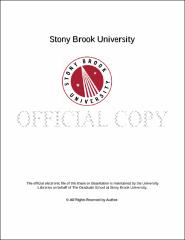| dc.identifier.uri | http://hdl.handle.net/11401/76540 | |
| dc.description.sponsorship | This work is sponsored by the Stony Brook University Graduate School in compliance with the requirements for completion of degree. | en_US |
| dc.format | Monograph | |
| dc.format.medium | Electronic Resource | en_US |
| dc.language.iso | en_US | |
| dc.publisher | The Graduate School, Stony Brook University: Stony Brook, NY. | |
| dc.type | Dissertation | |
| dcterms.abstract | Increasing rates of antibiotic resistance are challenging the status quo and raising the possibility of a post-antibiotic era, in which even common infections could become life threatening. This looming health crisis highlights the immediate need for new and effective therapies, which not only neutralize bacterial pathogens but also limit the development of resistance. A new class of molecules known as anti-virulence therapeutics targets the bacterial virulence factors used to establish disease in the host. This is in contrast to traditional antibiotics, which disrupt essential processes required for bacterial survival. One such virulence target includes adhesive fibers, termed pili, assembled by a conserved mechanism known as the chaperone/usher (CU) pathway. P and type 1 pili are prototypical examples of pili assembled by the CU pathway. These pili are utilized by uropathogenic Escherichia coli to colonize host tissues and establish urinary tract infections (UTIs). UTIs are the second most common infection of the human body, and uropathogenic E. coli is a pathogen that displays high incidences of antibiotic resistance clinically. To address the need for new antimicrobial agents, I have identified a new use and mechanism of action for the FDA approved anti-parasitic drug nitazoxanide (NTZ). I have shown that NTZ inhibits the assembly of adhesive pili on the surface of E. coli in a dose dependent manner. Using a combination of genetic and biochemical techniques, I demonstrated that NTZ prevents proper maturation the usher protein in the bacterial outer membrane (OM). The usher is an essential part of the CU pathway and serves as a platform for pilus assembly and secretion. Furthermore, I have obtained genetic evidence strongly suggesting that NTZ targets an essential OM complex known as the ß-barrel assembly machinery (Bam), which is required to fold the usher. This work not only identifies NTZ as a potential anti-virulence compound to treat pilus-mediated diseases such as UTIs, but also provides the first described chemical tool to investigate the functionality of the Bam complex. Additionally, this work highlights the value of both CU pili and the Bam complex as therapeutic targets. | |
| dcterms.abstract | Increasing rates of antibiotic resistance are challenging the status quo and raising the possibility of a post-antibiotic era, in which even common infections could become life threatening. This looming health crisis highlights the immediate need for new and effective therapies, which not only neutralize bacterial pathogens but also limit the development of resistance. A new class of molecules known as anti-virulence therapeutics targets the bacterial virulence factors used to establish disease in the host. This is in contrast to traditional antibiotics, which disrupt essential processes required for bacterial survival. One such virulence target includes adhesive fibers, termed pili, assembled by a conserved mechanism known as the chaperone/usher (CU) pathway. P and type 1 pili are prototypical examples of pili assembled by the CU pathway. These pili are utilized by uropathogenic Escherichia coli to colonize host tissues and establish urinary tract infections (UTIs). UTIs are the second most common infection of the human body, and uropathogenic E. coli is a pathogen that displays high incidences of antibiotic resistance clinically. To address the need for new antimicrobial agents, I have identified a new use and mechanism of action for the FDA approved anti-parasitic drug nitazoxanide (NTZ). I have shown that NTZ inhibits the assembly of adhesive pili on the surface of E. coli in a dose dependent manner. Using a combination of genetic and biochemical techniques, I demonstrated that NTZ prevents proper maturation the usher protein in the bacterial outer membrane (OM). The usher is an essential part of the CU pathway and serves as a platform for pilus assembly and secretion. Furthermore, I have obtained genetic evidence strongly suggesting that NTZ targets an essential OM complex known as the ß-barrel assembly machinery (Bam), which is required to fold the usher. This work not only identifies NTZ as a potential anti-virulence compound to treat pilus-mediated diseases such as UTIs, but also provides the first described chemical tool to investigate the functionality of the Bam complex. Additionally, this work highlights the value of both CU pili and the Bam complex as therapeutic targets. | |
| dcterms.available | 2017-09-20T16:50:36Z | |
| dcterms.contributor | Thanassi, David G | en_US |
| dcterms.contributor | Bliska, James | en_US |
| dcterms.contributor | Karzai, Wali | en_US |
| dcterms.contributor | Tonge, Peter | en_US |
| dcterms.contributor | Silhavy, Thomas. | en_US |
| dcterms.creator | Chahales, Peter Nicholas | |
| dcterms.dateAccepted | 2017-09-20T16:50:36Z | |
| dcterms.dateSubmitted | 2017-09-20T16:50:36Z | |
| dcterms.description | Department of Molecular Genetics and Microbiology. | en_US |
| dcterms.extent | 154 pg. | en_US |
| dcterms.format | Application/PDF | en_US |
| dcterms.format | Monograph | |
| dcterms.identifier | http://hdl.handle.net/11401/76540 | |
| dcterms.issued | 2015-12-01 | |
| dcterms.language | en_US | |
| dcterms.provenance | Made available in DSpace on 2017-09-20T16:50:36Z (GMT). No. of bitstreams: 1
Chahales_grad.sunysb_0771E_12592.pdf: 5665393 bytes, checksum: b5b09a04afc0cbe8b3c95c67bb7af5f8 (MD5)
Previous issue date: 1 | en |
| dcterms.publisher | The Graduate School, Stony Brook University: Stony Brook, NY. | |
| dcterms.subject | Microbiology | |
| dcterms.subject | Bam complex, Chaperone, Nitazoxanide, Pili, Usher | |
| dcterms.title | Inhibition of Chaperone/Usher Pilus Assembly by Nitazoxanide | |
| dcterms.type | Dissertation | |

